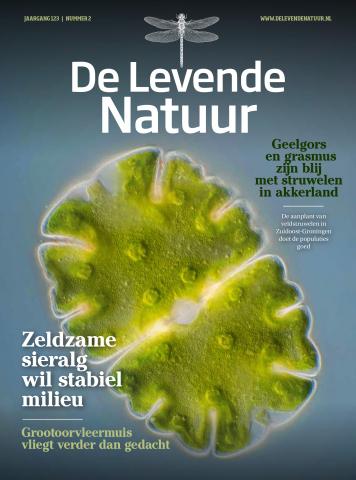De Levende Natuur nummer 2 van 2022 (English summary)
Afbeelding

Brown long-eared bats use hop overs to cross Frisian road
Dirk Oosterholt & Johann Prescher
Brown long-eared bats forage in various kinds of forested habitats in the vicinity of their roosts. Roads are well known barriers. Hop overs were built as mitigation for road construction. In 2019 ten brown long-eared bats were radio tagged and telemetrically tracked to evaluate use of hop overs. Four out of ten were observed crossing at hop overs. But the bats also crossed roads without hop overs. The surrounding bocage landscape was important both for foraging and as flyway between roost and foraging grounds. The long-eared bats surprisingly flew further than previously described, up to 6 kilometers. The bats also used a less known foraging habitat: peat bogs.
Dead trees bring life to the river
Arne Klink, Joost van Deelen, Ton van Haaren, Margriet Schoor & Amy de Beauvesere-Storm
Dead trees in river water are a habitat for aquatic organisms such as fish, macroinvertebrates and algae. In Dutch rivers dead wood is rare and trees often are removed to avoid the risk of obstructing shipping. To restore aquatic biodiversity in the large rivers, Rijkswaterstaat placed several tens of dead trees in the rivers Waal and IJssel. These trees were sampled in 2018-2020 to analyse the macroinvertebrate diversity. As a reference macroinvertebrate samples were also taken from bare stones. The inventories showed hopeful results in increase of aquatic invertebrates, including species indicative of high water quality. The most abundant families found were amphipods, bristle worms, chironomids, mysids, dragonflies, damselflies, mayflies, water lice and mud shrimps.
Desmids do not recover from acidification: a century of monitoring in three moorland pools
Herman van Dam & Koos Meesters
The changes, mainly due to acidification, in the desmid flora of three moorland pools between 1916 and 2014 were investigated. The shifts are greatest in pools with relatively flat banks exposed to the air in extremely dry summers. After the dry summer of 1921, the changes were slight, but after the dry summer of 1976, the changes were dramatic due to the release of the sulphur and nitrogen compounds from the water bottom. The desmid conservation value declined but increased again until the 1990s, partly due to the decrease in acidifying deposition. The continuous decrease of acid deposition did not restore the desmid flora; on the contrary, the conservation value decreased again. The chemical dynamics resulting from the large stock of sulphur and nitrogen compounds, which have been built up in a century, are not conducive to the development of rare desmid species, which are bound to stable environmental conditions.

